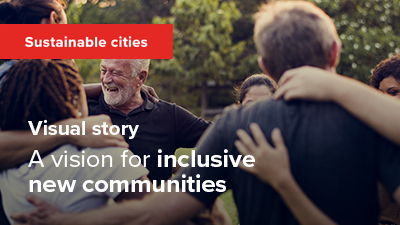From experience
High quality, affordable housing is high on the political agenda in many cities. So too is improving health and wellbeing by creating safe neighbourhoods, improving air quality, creating attractive open spaces for physical activity and providing community facilities for socialising. Essentially, the focus is on placemaking for lasting social benefit. We have experience and expertise in all these areas.
Social, environmental and economic: We work with many clients – public and private – to unlock the potential of underutilised land and property assets in urban areas. For example, we’re supporting Transport for London (TfL) as it seeks to realise the potential of its property portfolio, through the creation of high quality sustainable development schemes that will create thousands of homes, drive economic growth and deliver positive social outcomes across the city, with the underlying principle of generating much needed revenue for re-investment in the transport infrastructure.
Affordable homes: We worked with the London Borough of Southwark to create hundreds of new affordable homes. These projects promoted new and inclusive neighbourhoods, with specialist accommodation for wheelchair users and community facilities for older people and those in need of care. These developments were the first to be built in the borough in more than 10 years and brought many previously underused or vacant sites into use.
Healthy cities: By bringing together our healthcare and built environment professionals, we were able to produce a best practice guide for TfL on the development of healthy cities. It considers how the built environment can positively contribute to the physical health and mental wellbeing of the people that work, live and play in cities – and describes key principles for creating heathier places that benefit society, and profoundly improve lives.
Sustainability strategies: We provide strategic management and technical support to TfL for the implementation and ongoing development of its cutting-edge Sustainable Development Framework (SDF), driving best practice sustainability outcomes across the organisation’s broad programme of development projects throughout London. In Australia, we are developing regenerative design guidelines for Transport for New South Wales as the agency also seeks to drive positive social outcomes through its ongoing development activities.
Green infrastructure: In Philadelphia, we worked with the city’s water department on its green infrastructure programme. Like many older cities, much of Philadelphia is served by combined sewers that carry both sewage and stormwater. When it rains heavily or there is rapid snow melt, the sewers are overloaded and discharge into local rivers. We designed ways of holding water back to avoid this – extending curbs to include vegetated infiltration trenches and planters that collect drainage from the street. The result is less runoff and pollution, creating greener streets and a cleaner river for Philadelphians.
Reducing carbon: Moata Carbon Portal is our design optioneering tool to identify capital and operational carbon ‘hot spots’ in projects and to develop the lowest carbon, best value solutions. It is used from the early stages of project development, where key decisions are made, and to help deliver carbon and cost savings through to project delivery and beyond. We used Carbon Portal when designing the waterfront enhancement at Colwyn Bay, Wales, shaping our solution to achieve a 30% reduction in embodied carbon as a result.
Digital solutions: Carbon Portal is just one of growing suite of digital solutions to automate and speed up the design, development and delivery of our projects. All are hosted on our digital platform Moata. Moata Geospatial, for example, enables stakeholders to collaborate around geospatial data in a common data environment and build a digital twin – digital representations of physical things – bringing benefits to clients, operators and community stakeholders at every stage of the lifecycle of a building or infrastructure asset, as they see ideas and solutions taking shape.
Modern methods of construction: We are passionate about efficient, progressive design solutions. Integral to that is the adoption of modern methods of construction, such as design for manufacture and assembly (DfMA). Offsite construction and onsite delivery can deliver high-quality projects more efficiently and more quickly, and for less cost. DfMA can also reduce disruption to communities and cut material waste and whole-life carbon. Some 70% of components – from structural and flooring systems to stairs, lifts and bathrooms – can be manufactured offsite, reducing construction time on site by up to two thirds, improving build quality and worker safety.
Better delivery: Building information modelling (BIM) and DfMA sit together, and we used both on the £35M Royal Victoria Building at Edinburgh’s Western General Hospital. By value, 55% was made offsite under factory conditions, with dimensions and structural information in a 3D BIM model used by the manufacturer to produce components. Similarly, we’re employing a modular, DfMA approach to deliver schools in England as part of the government’s Priority School Building Programme. Each modular school takes three months to complete – compared with 10 months for traditional approaches – minimising disruption during construction and creating space quickly to meet demand and improve facilities.





